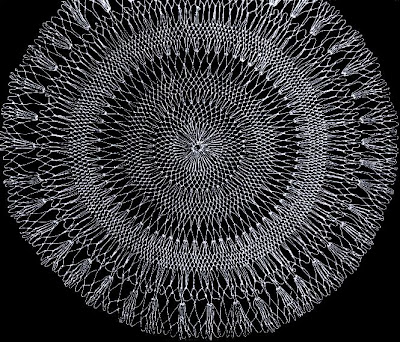Several years ago I stumbled across some articles on netting that had been published between 1968 and 1982 by the IOLI. This week I found those same articles located in two places, here and here.
According to their website, IOLI was founded in 1954 as Old Lacers. Their name has been changed several times: 1959 to National Old Lacers, 1970 to International Old Lacers, Inc., and 2012 to International Organization of Lace, Inc.
Here are some of the articles about netting I found in this quarterly magazine.
- September 1970
- Section: Art of Netting; Article: Corner in Darned or Guipure Netting (page 11)
- Section: Art of Netting; Article: Netted Neckerchief (page 11)
- January 1971
- Article: Filet (page 40)
- January 1973
- Section: Netting and Guipure; Article: Netting (page 39)
- Section: Netting and Guipure; Article: South Beloit Women Preserve Lacemaking, Antique Lace Made (page 40)
- May 1973
- Article: Netting (photo of doily made by Mrs. Frank Nelson) (page 65 )
- Section: Book Review; Author: Mary Lou Kueker; Article: Netting by Primrose Cumming (page 78)
- Section: Book Review; Author: Mary Lou Kueker; Article: La rete a Rosoni (Rosette Netting) (page 78)
- Section: Book Review; Author: Mary Lou Kueker; Article: A Treasury of Needlework Projects from Godey's Lady's Book by Arlene Z. Wiczyk (page 78)
- November 1976
- Article: Netting (page 26)
- Article: Filet Lace (page 27)
- November 1977
- Author: Sheila Bottorff; Article: Tatting-Frivolite [includes illustrations for tying the netting knot] (page 44)
- May 1977
- Section: A Book of Modern Netting Designs; Author: Mrs. Bertha Cragun; Article: "Kissin' Cousin" fantail fish design (photo only) (page 98)
- Section: Filet Square; Author: Kay Asahi; Article: Single or plain mesh (page 99 )
- January 1978
- Section: A Practical Use of Netting; Article: Netted Doily (page 70)
- Section: A Practical Use of Netting; Article: Netting the New Wool Scarfs (page 70)
- Section: A Practical Use of Netting; Article: Netted Edging (page 70)
- July 1979
- Section: Modano Lace; Author: Mrs. Bertha Cragun; Article: Modano Lace (page 139)
- January 1980
- Section: Modano Lace; Author: Mrs. Bertha Cragun; Article: Circle It [net doll skirt] (page 52)
- Section: Modano Lace; Author: Mrs. Bertha Cragun; Article: Garden Party [netting on Pillow Cases] (page 52)
- Section: Modano Lace; Author: Mrs. Bertha Cragun; Article: Lacy Shawl (page 53 )
- Section: Modano Lace; Author: Mrs. Bertha Cragun; Article: Garden Hat (page 53)
- Section: Modano Lace; Author: Mrs. Bertha Cragun; Article: Lace on Lace (page 53)
- Section: Modano Lace; Author: Mrs. Bertha Cragun; Article: Modano Lace Star for a Birthday Calendar of Calligraphy (page 53)
- May 1980
- Section: Modano Lace; Author: Mrs. Bertha Cragun; Article: Modano Lace [forming a center without a foundation loop] (page 92)
- Section: Modano Lace; Author: Mrs. Bertha Cragun; Article: Tool Keeper Tip (page 93)
- November 1980
- Section: Book Review; Article: The Technique of Filet Lace by Pauline Knight (page 26 )
- May 1981
- Section: Modano Lace; Author: Mrs. Bertha Cragun; Article: Pauline Knight [author of The Technique of Filet Lace] (page 69)
* * * * * * * * * * * * * *
Last Saturday I went to two baby showers. Although they were not held at the same time, they were held in the same large building. That made it easier to go from one to the other. As a gift, I brought what everyone who knows me expected - a net bag.
Since I am trying to get my instructions correct for my net bags before I publish them, I have two different styles here.
The blue bag is a rectangular bag with a single tied handle.
The pink bag is a circular bag made from the bottom up and has two handles.
Of course the bags contained some of my favorite baby bibs.
Judging from the comments at the baby showers I attend, the bibs are a favorite with other mothers also.
The baby bibs are made of tea-towels and have ribbing around the neck edge.







































